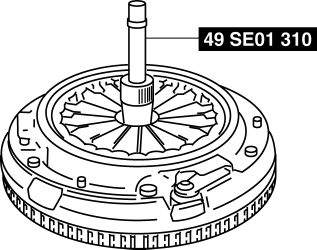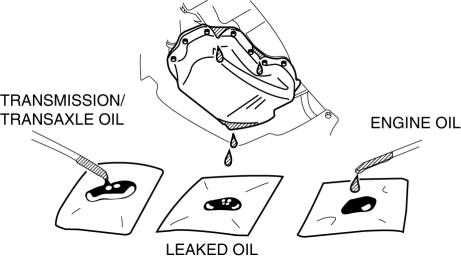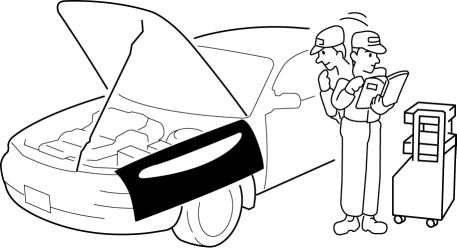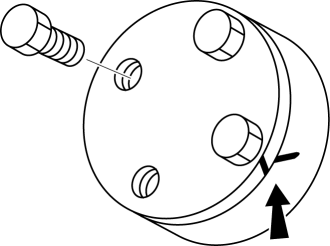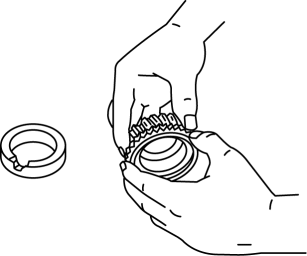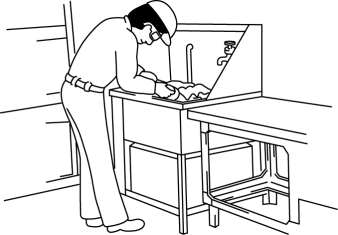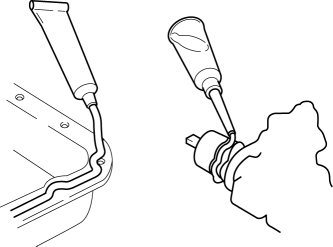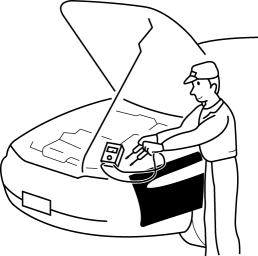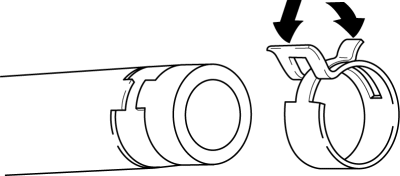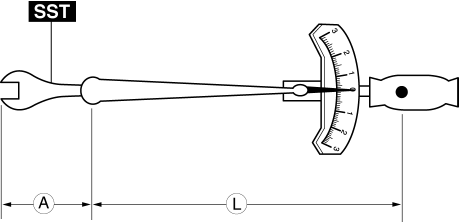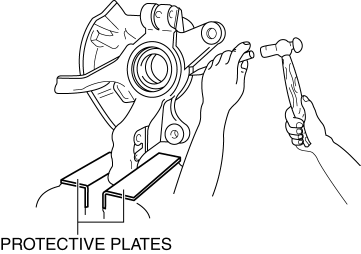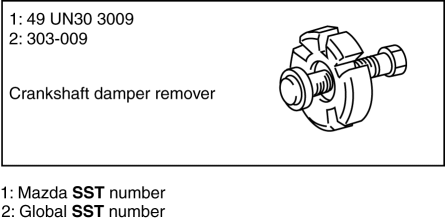SERVICE CAUTIONS
Injury/damage Prevention Precautions
Depending on the vehicle, the cooling fan may operate suddenly even when the ignition is switched off. Therefore, keep hands and tools away from the cooling fan even if the cooling fan is not operating to prevent injury to personnel or damage to the cooling fan. Always disconnect the negative battery cable when servicing the cooling fan or parts near the cooling fan.
Protection of the Vehicle
Preparation of Tools and Measuring Equipment
Special Service Tools
Malfunction Diagnosis System
Use the Mazda Modular Diagnostic System (M-MDS) for malfunction diagnosis.
Connection to malfunction diagnosis system
Oil Leakage Inspection
Use either of the following procedures to identify the type of oil that is leaking:
Using UV light (black light)
1. Remove any oil on the engine or transmission/transaxle.NOTE:
Referring to the fluorescent dye instruction manual, mix the specified amount of dye into the engine oil or transmission/transaxle oil.
2. Pour the fluorescent dye into the engine oil or transmission/transaxle oil.
3. Allow the engine to run for 30 min.
4. Inspect for dye leakage by irradiating with UV light (black light), and identify the type of oil that is leaking.
5. If no dye leakage is found, allow the engine to run for another 30 min. or drive the vehicle then reinspect.
6. Find where the oil is leaking from, then make necessary repairs.NOTE:
To determine whether it is necessary to replace the oil after adding the fluorescent dye, refer to the fluorescent dye instruction manual.
Not using UV light (black light)
1. Gather sample of the leaking oil using an absorbent white tissue.
2. Then, gather some samples of engine and transmission/transaxle oil onto a white cloth or piece of paper.
AT vehicles: ATF
3. Compare the appearance and smell, and identify the type of oil that is leaking.
4. Remove any oil on the engine or transmission/transaxle.
5. Allow the engine to run for 30 min.
6. Check the area where the oil is leaking, then make necessary repairs.
Negative Battery Cable Disconnection/Connection
Warning
Before removing the SRS air bag system-related parts, always disconnect the negative battery cable and wait for 1 min. or more to allow the back-up power supply to deplete its stored power. (See AIR BAG SYSTEM SERVICE WARNINGS [STANDARD DEPLOYMENT CONTROL SYSTEM].) (See AIR BAG SYSTEM SERVICE WARNINGS [TWO-STEP DEPLOYMENT CONTROL SYSTEM].)
Required procedure after negative battery cable disconnection/connection
| System name |
Conditions after disconnecting the negative battery cable |
Required procedure |
Reference |
||
| Before disconnecting negative battery cable |
After connecting negative battery cable |
||||
| Clock and audio |
Clock display and audio system memory are reset. |
Verify the setting content. |
Set the verified content before disconnecting negative battery cable. |
??? |
|
| Tire pressure monitoring system (TPMS) |
The tire pressure monitoring system detection accuracy decreases. |
??? |
Perform the tire pressure monitoring system initialization. |
(See TIRE PRESSURE MONITORING SYSTEM INITIALIZATION PROCEDURE.) |
|
Switch The Power Supply Using The Push Button Start And Start The Engine
Based on the push button start signals, the start stop unit switches the power supply circuit by turning on/off the relay according to the vehicle conditions such as the position of the selector lever (AT)/shift lever (MT) and depression/release of the brake pedal (AT)/clutch pedal (MT).
By pressing the push button start under the conditions shown in the figure, the ignition can be switched.
- *1
- To switch the ignition ACC or OFF from ON (engine on), the vehicle speed must be 5 km/h {3 mph} or less.
Removal of Parts
Control module configuration (initialization setting)
CAUTION:
If the configuration procedure is not completed correctly after replacing a control module in which configuration is required, the system will not operate normally. Therefore, perform the work in accordance with the replacement procedure in the workshop manual.
If the control module is replaced, and depending on the control module, it may be necessary to write the vehicle specification data to the new control module using the M-MDS. This procedure is for performing the configuration (initial setting).
There are the following three methods of the configuration procedure for the control module:
Automatic configuration
The main control module (built into instrument cluster) performs configuration of the new control module itself and automatically using the vehicle specification data sent via CAN lines.
Configuration based on vehicle information read/write data
Reads the vehicle information from the control module prior to replacement, and writes the vehicle information to a new control module.
Configuration by As-Built data:
Obtains the vehicle specification data when the vehicle is shipped from the factory, and writes the data to a new control module.
The configuration using As-Built data is used if the vehicle information cannot be read due to a damaged control module which is to be replaced, or if a DTC such as a configuration malfunction is detected.
If a control module having personalization features is configured using As-Built data, the settings personalized by the customer are initialized (to factory settings). In this case, verify the setting values made by the customer and change the personalized setting values using the ???Programmable Parameters??? from the M-MDS menu.
If the module programming menu of the M-MDS (Programmable Module Installation, As-Built, Programmable Parameters) is performed, perform the procedure while the battery monitor icon of the M-MDS is green or gray.
Disassembly
Inspection During Removal, Disassembly
Arrangement of Parts
Cleaning of Parts
WARNING:
Using compressed air can cause dirt and other particles to fly out causing injury to the eyes. Wear protective eye wear whenever using compressed air.
Reassembly
If removed, these parts should be replaced with new ones:
| Oil seals |
Cotter pins |
| Gaskets |
Locknuts (Nylon nuts) |
| O-rings |
Spring pins |
| Lock washers |
??? |
Depending on location:
Sealant and gaskets, or both, should be applied to specified locations. When sealant is applied, parts should be installed before sealant hardens to prevent leakage.
Oil should be applied to the moving components of parts.
Specified oil or grease should be applied at the prescribed locations (such as oil seals) before reassembly.
Adjustment
Rubber Parts and Tubing
Hose Clamps
Torque Formulas
| Torque Unit |
Formula |
| N·m |
N·m × [L/(L+A)] |
| kgf·m |
kgf·m × [L/(L+A)] |
| kgf·cm |
kgf·cm × [L/(L+A)] |
| ft·lbf |
ft·lbf × [L/(L+A)] |
| in·lbf |
in·lbf × [L/(L+A)] |
- A
- The length of the SST past the torque wrench drive.
- L
- The length of the torque wrench.
Vise
Dynamometer
Cautions on chassis dynamometer use
When inspecting and servicing the powertrain on the dynamometer or speedometer tester, pay attention to the following:
NOTE:
If the engine cannot be stopped using the push button start, perform an emergency engine stop operation. (See Emergency Engine Stop Operation.)
Place a fan, preferably a vehicle-speed proportional type, in front of the vehicle.
Make sure the vehicle is in a facility with an exhaust gas ventilation system.
Keep the rear bumper cool by placing a cooling fan near the exhaust pipe so that the rear bumper does not get deformed by the heat from the exhaust.
Keep the area around the vehicle uncluttered so that heat does not build up.
Watch the water temperature gauge and do not overheat the engine.
Avoid added load to the engine and maintain normal driving conditions as much as possible.
Servicing on vehicles with ABS/DSC
If only the front or rear wheels are rotated using a chassis dynamometer, the DSC HU/CM determines that the ABS/DSC is malfunctioning, detects a DTC, and turns on the related warning light at the same time. (See DTC TABLE [DSC HU/CM].)
If the light is turned on, remove the vehicle from the chassis dynamometer and switch the ignition OFF (LOCK). Then switch the ignition ON (engine on) and drive the vehicle at 20 km/h {12 mph} or more, and verify that the warning light turns off. The DTC is stored in the memory, therefore erase it by following the ON-BOARD DIAGNOSIS SYSTEM [DSC HU/CM]. (See CLEARING DTC [DSC HU/CM].)
NOTE:
If the engine cannot be stopped using the push button start, perform an emergency engine stop operation. (See Emergency Engine Stop Operation.)
Emergency Engine Stop Operation
While performing an inspection by rotating the wheels using a dynamometer, if the ABS HU/CM (with ABS system) or DSC HU/CM (with DSC system) detects a vehicle speed signal error, the engine cannot be stopped using the push button start. If the engine cannot be stopped using the push button start, perform an emergency stop using the following procedure.
1. Press and hold the push button start for approx. 3 s or more, or press it three times or more successively within approx. 1.5 s.
2. The engine stops (position is ACC).
3. Press the push button start to switch the ignition OFF.
SST
Some global SST or equivalent are used as SSTs necessary for vehicle repair. Note that these SSTs are marked with global SST numbers.
Note that a global SST number is written together with a corresponding Mazda SST number as shown below.
Example (SST List)
Example (In text)
< Previous Next >

